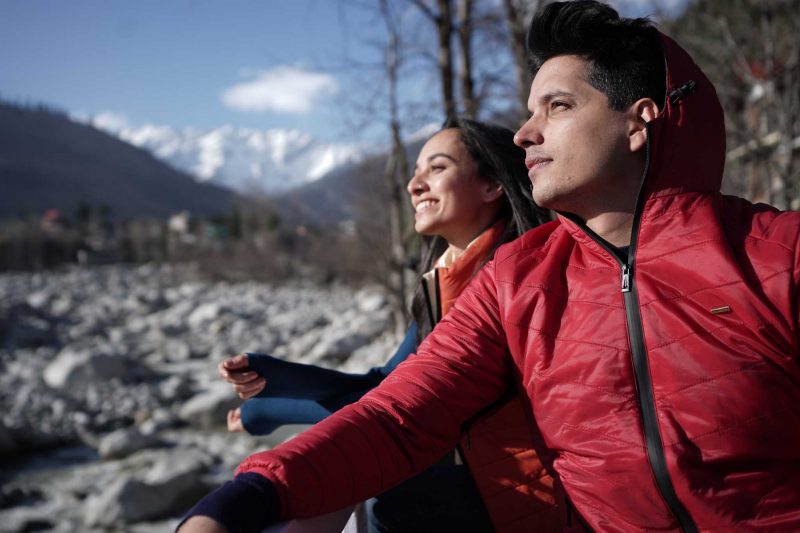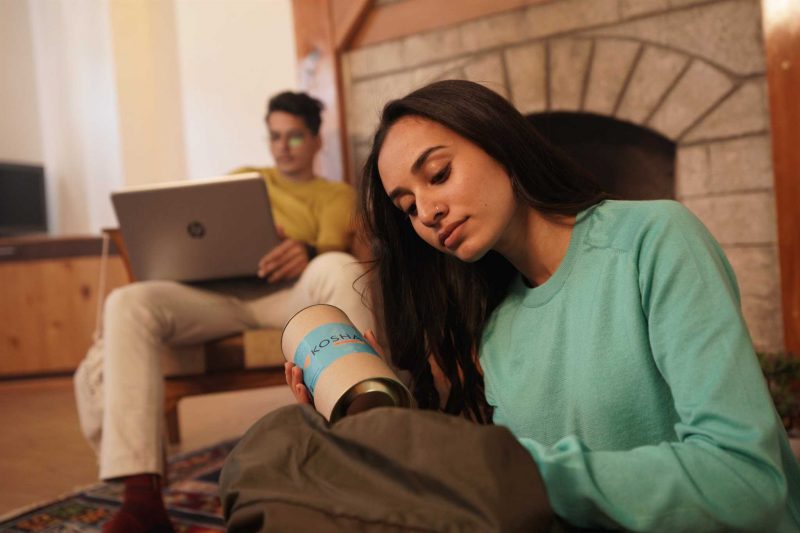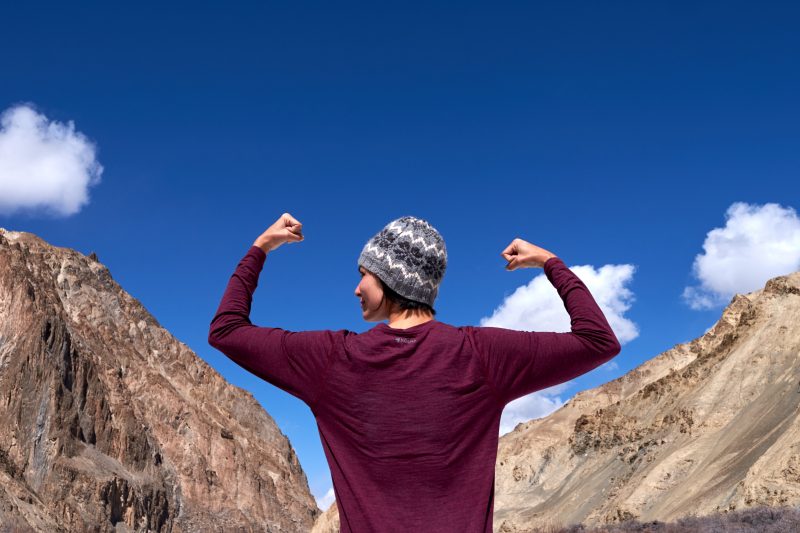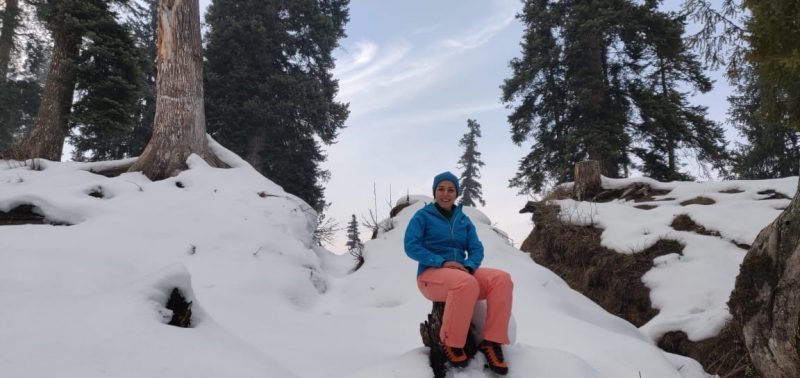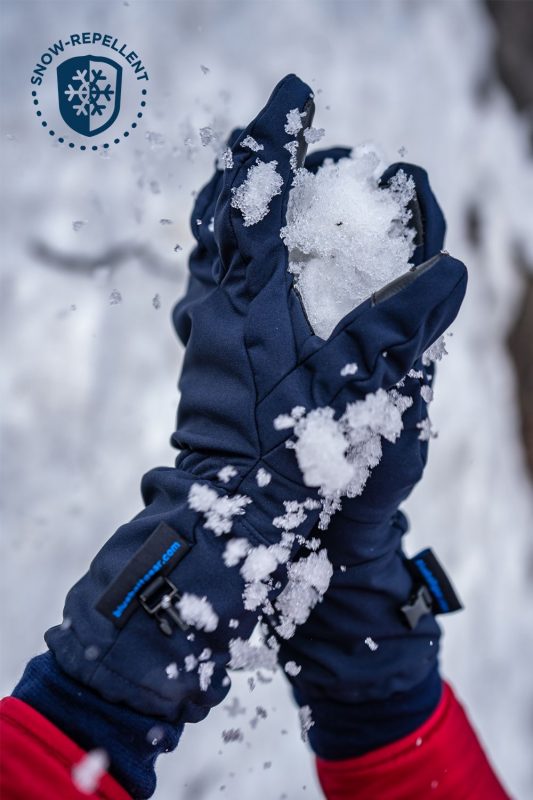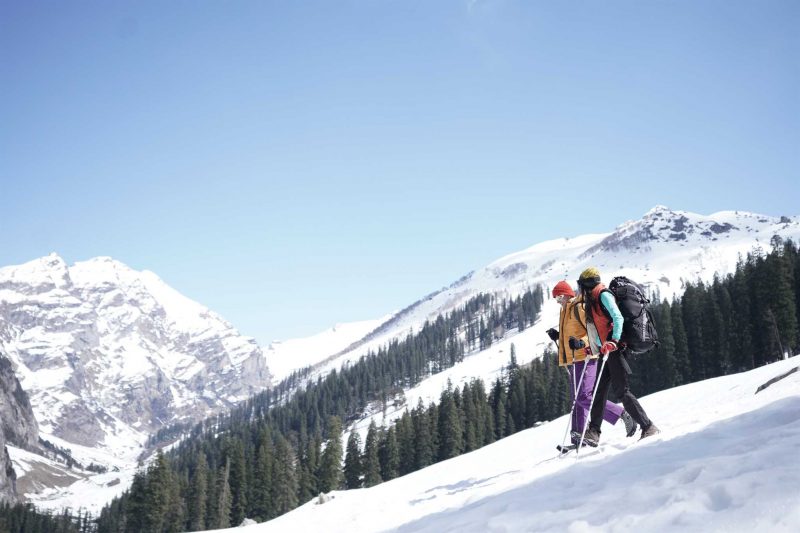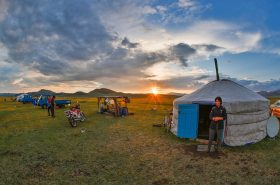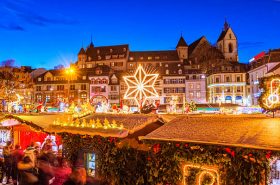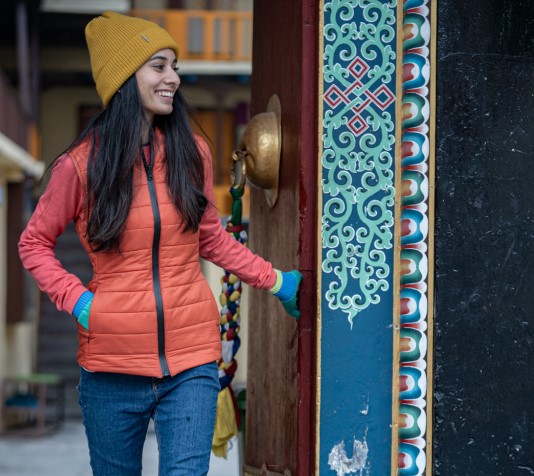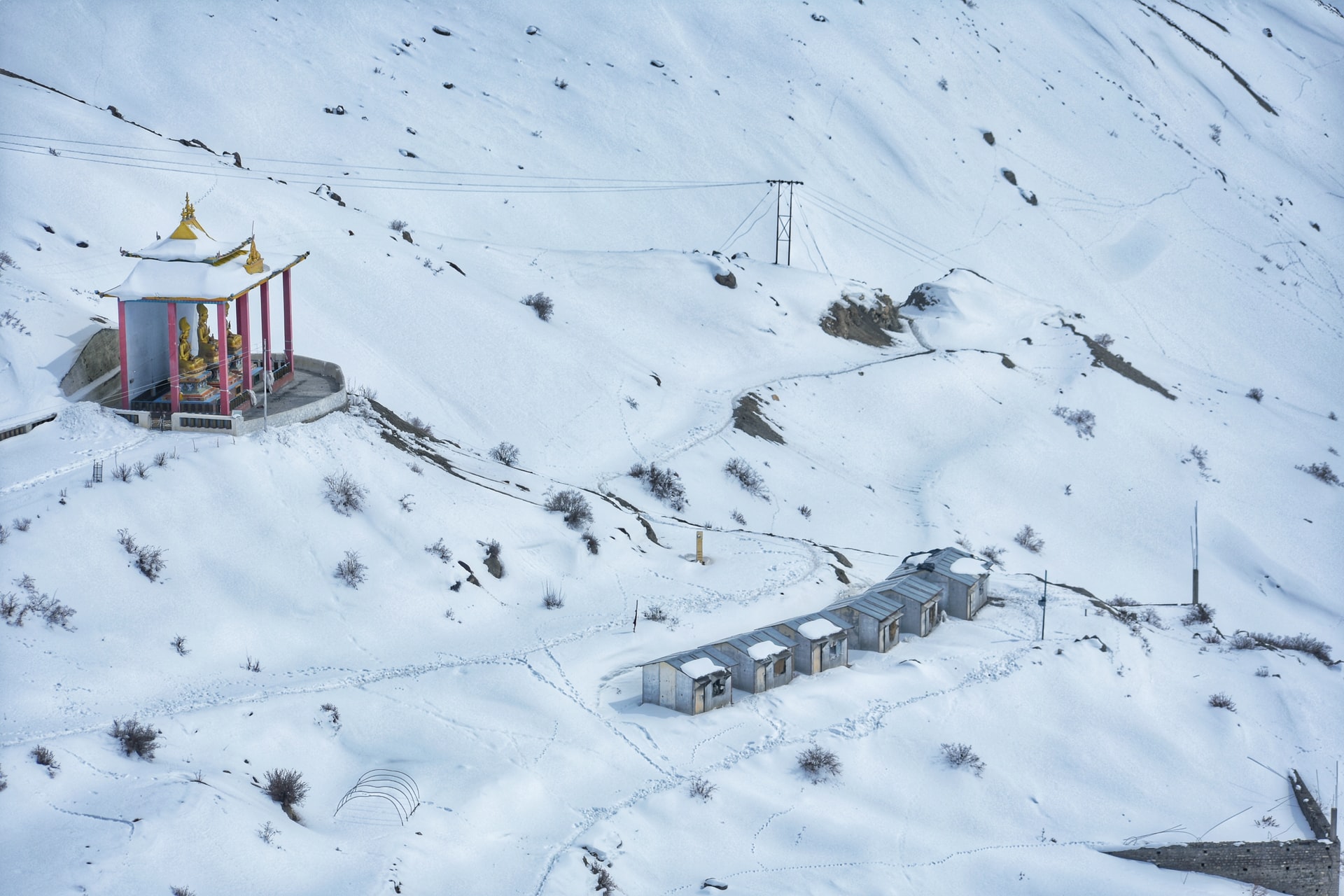
Spiti Valley in winters is a mesmerizing snow paradise. Read on to find out how to plan a trip there!
One of my long-awaited bucket list items is solo travel. I’ve decided to cross this off recently.
After considering many places, I have chosen to explore one of the most beautiful untouched places with infinite adventure – “Spiti Valley”.
I heard that traveling to Spiti Valley in winter is quite challenging. It is going to be challenging for me as I don’t know how to speak Hindi, I can understand only a few words.
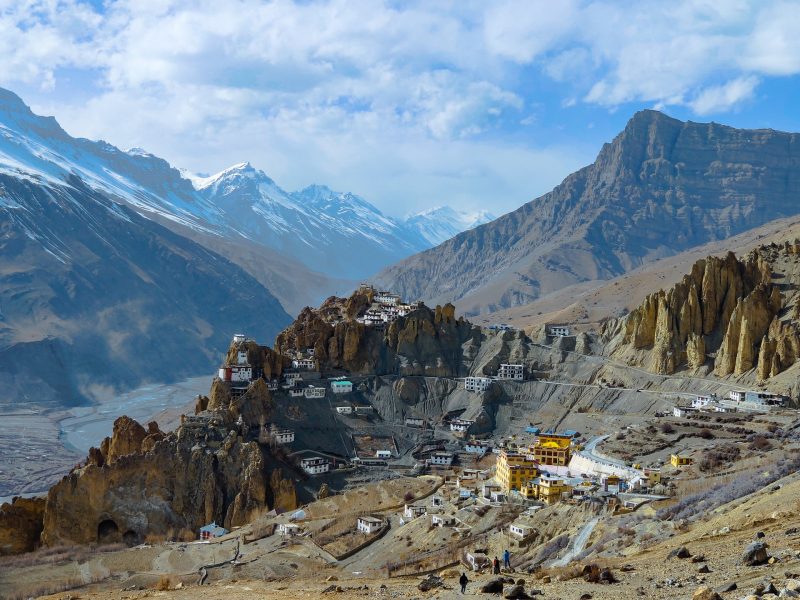
Spiti Valley Winter Guide
As rightly said, “Travel is never a matter of money, it’s a matter of courage”.I have prepared myself physically and mentally with the courage to experience my first solo trip. Let’s begin our Spiti Trip now 🙂
Things to do in Spiti Valley in winters
Where is Spiti Valley located?
Spiti Valley is a mountainous cold desert located in Himachal Pradesh. The mighty Himalayas, bluish waters, uninhabited villages, adds beauty to the Spiti. It is located at an altitude of 12,500 feet above sea level.
The literal meaning of Spiti is “The Middle land”. As the name suggests, it lies between India & Tibet. This is the reason why the spiti possesses a distinctive Tibetan Buddhism culture.
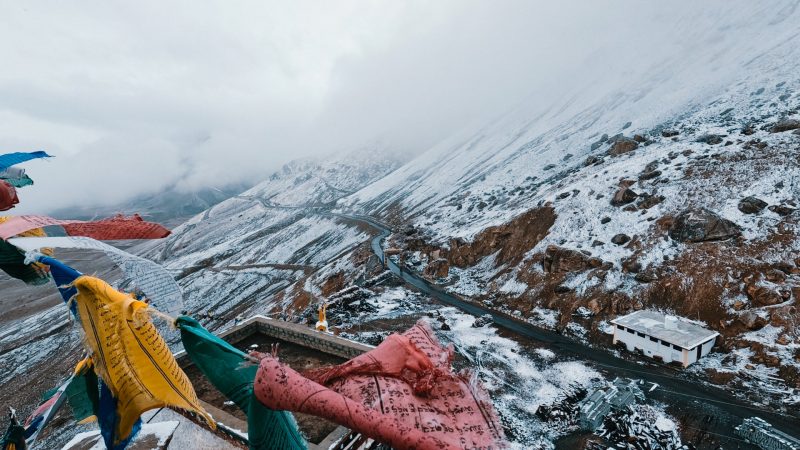
Spiti Valley
Many think Lahaul and Spiti are different. Both the districts are merged. Their administrative center is Kyelang.
How to Reach
There are no direct buses /trains /flights connecting directly to Spiti Valley. You have to start your trip either from Delhi or Chandigarh and from Delhi/Chandigarh, you have to head towards Shimla or Manali by car.
First, pick from these choices and plan your trip accordingly. I have shared the routes for both choices.
- Delhi or Chandigarh
- Shimla or Manali.
We can reach Spiti valley in either of the below routes-
- Delhi – Shimla – Spiti
Distance – 425 km approx
Travel Route can be – Delhi -Shimla -Narkanda-Kalpa-Nako-Spiti (Or) Chandigarh – Shimla – Kaza.
- Manali- Spiti
Distance – 195 km approx
Travel Route can be – Delhi -Manali-Rohtang Pass -Gramphu-Kunzum Pass -Spiti. (Or) Chandigarh – Manali – Kaza.
Both these routes are scenic, if the trip is done in such a way that you start from Shimla and end with Manali, you can get views of both the routes.
By Flights –
Option A – Flight to Kullu/Shimla/ Chandigarh from Delhi.
From Delhi, one can fly by air to Kullu/Shimla/Chandigarh Airports. Kullu airport(Bhuntar Airport) is considered to be one of the challenging airports due to its location. We cannot rely on flights due to the changing weather conditions.
Shimla airport is one of the table-top airports of India and similar to operations of Kullu. So the better option is to opt for the Chandigarh flight. Then travel to Shimla or Manali to reach Spiti via Road.
Option B – Chandigarh.
Take a direct flight to Chandigarh from any major city of India -Be it Delhi/Mumbai/Chennai/Bengaluru. Then travel to Shimla or Manali via Road.
Delhi and Chandigarh are connected with good road/rail/air connectivity from all major places of India. Check the options available across the websites according to your itinerary and book in advance.
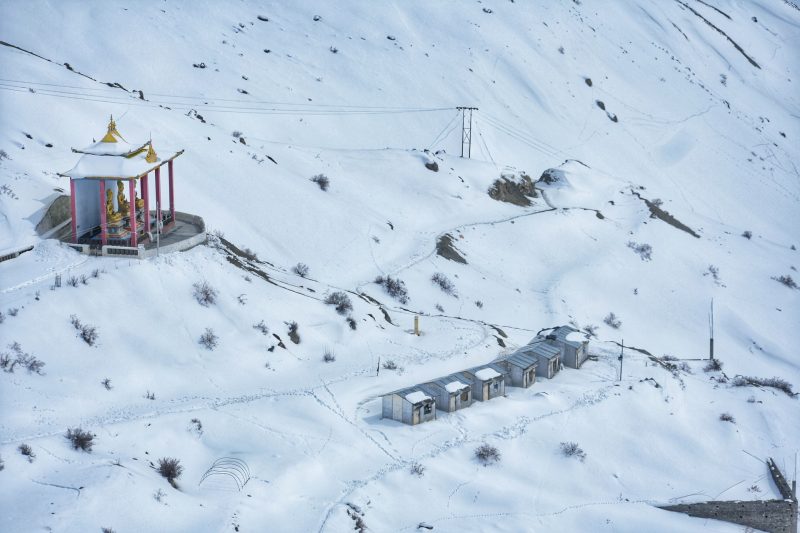
Spiti Valley in winters
By Buses –
From Delhi
- Volvo AC buses and Ordinary buses are available from Delhi ISBT ( Kashmiri Gate ) to Shimla
Time – 9 to 10 hours approx.Fare – INR 500 – 1000 per person.
- Himachal Pradesh Tourism Development Corporation (HPTDC) also runs buses from Delhi to Shimla and Manali (Vice-versa routes too).
Depart from Delhi – Himachal Bhawan, Mandi House, New Delhi
Depart from Shimla – Victory Tunnel ,Shimla.
Depart from Manali -HRTC Bus Stand ,Manali.
You can reserve the tickets here. Online reservations can be made up to 2 hours before the bus’ departure date, subject to seat availability.
From Chandigarh –
Private Buses and HRTC buses are available from Chandigarh to Manali and Shimla.
By Taxis –
The fare differs according to the vehicle you choose, the agency, and the travel season. Prices are given for a one-way trip.
- Chandigarh to Shimla – From INR 2500 to INR 7000.
- Chandigarh to Manali – From INR 4000 to INR 8000
- Delhi to Shimla – From INR 4500 to INR 6500
- Delhi to Manali – From INR 6000 to INR 9000.
How to reach Spiti from Shimla / Manali –
You need to hire a taxi, with an experienced driver to travel on both routes. Sometimes you need to face landslides and have to wait for clearance of the road.
1. From Shimla –
This route will allow you to avoid getting permits for Rohtang Pass. This route lets you ascend gradually without the risk of getting hit by Acclimatization issues. You also get access to view Hatu Peak, Chitkul, and Kalpa.
Start from Shimla by early morning, your first stop will be Narkanda(9000 ft). You can stay overnight. and head to Kalpa the next day. On your way to Kaza, you can stop at Nako / Tabo.
Reach Kaza – stay Overnight – Enjoy your coolest early morning and move ahead to other places as per your convenience.
Route : Shimla – Narkanda – Rampur – Kalpa – Nako-Giu Village – Tabo Village – Dhankar – Pin Valley (Mud Village) – Kaza
- From Manali-
This route is a difficult one when compared to the above. As per the distance, it is considered to be the shortest route to reach Spiti. But the worst condition of the road will extend your travel time.
Accamalitisation is difficult in this route, please be sure to carry medicines or check with the doctor before you start. You have to get the permit for your vehicles in Rohtang Pass, so carry all the necessary documents to avoid the delay.
Route : Manali – Solang Valley – Rohtang Pass – Gramphu – Batal – Chandrataal – Kunzum Pass – Losar – Kaza – Dhankar – Tabo
How long is required for the Trip?
Plan a trip for 10 – 14 days. As mentioned above it takes 2 to 3 days from Shimla /Manali to reach the Spiti Valley. If you are not comfortable traveling by road for longer hours or you are traveling to such a high place for the first time then I suggest planning for two weeks.
Seasons and Average winter temperatures in Spiti Valley
January, February, March, and Mid April – The weather will be worse and most of the places are closed due to this reason. These months are not suitable for planning your trip. The temperature during this month will range from -7 degrees C to -25 degrees C.
April end, May, June, July – This is the best time to visit, the valley is extremely pleasant and warm during the summers, that is, between May and July. The temperature during this month will range from 4 degrees C to 28 degrees C.
August, September, October – The best time, but the temperature will go down to 4″ C, and nights will be extremely cold.
November, December – Better to avoid these months, landslides will be higher in these months due to rain. Temperature can go down to -2 degrees C.
In the summer, the days will be sunny and you don’t need to wear thermals, but at night the temperature will go down so you need to protect yourself with warm clothes. I have shared the importance of layering at the end of the blog. You must go through it and pack your backpacks.
Activities
- Key Monastery
This is the first time I am visiting a Buddhist Monastery. I was awestruck by the architecture and mural paintings. The smile of the Buddhist monks, the smell of incense sticks, cold wind, and the picturesque location give us a peaceful vibe. It is known as Kye Gompa. Gompa means the place of learning or a university associated with Tibetan Buddhism. It is the largest monastery in the Spiti valley.
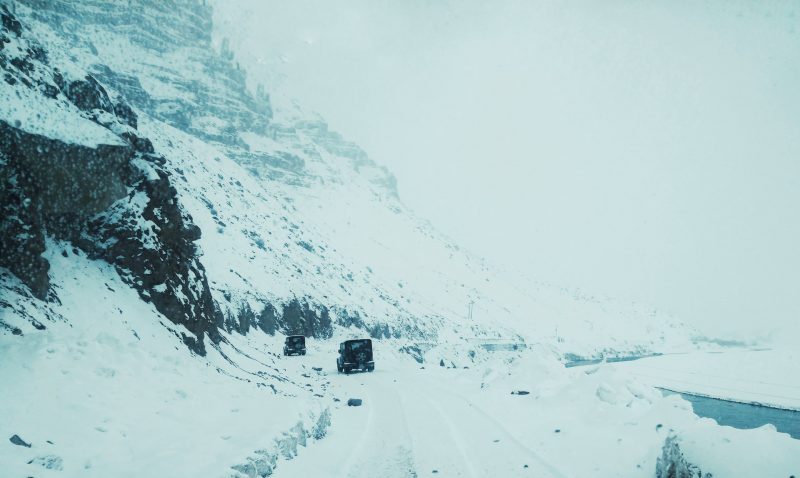
Snow covered Spiti Valley
Monastery has 3 floors – Assembly hall, Tangyur, and Underground Storage room. (Tengyur or Tanjur is the Tibetan collection of commentaries to the Buddhist Teachings). A Buddhist monk served herbal tea to me. I couldn’t figure out how it was made.
Chaam festival is being celebrated during June/July. If you visit during these months, you can enjoy the Masked dances and rituals by Monks. Accommodation options are available for the male guest only including a simple food option. You can reach out to their office directly for booking.
INR 200 will be charged and you can stay up to a maximum of 3 days.
Altitude – 4166 m above sea level.
How to reach Key Monastery –
It is approximately 440km from Shimla city and it will take around 16 to 18 hours if you are going by car from Shimla. If going by bus then you will have to take a halt at Reckong Peo and change to a bus for Kaza. And from Kaza, you will have to hire a taxi and the distance is 12 km. You will have to hike for 1 km to reach the spot.
- Camping at Chandratal Lake –
Chandratal lake gets its name from the word Chandra – moon, also it is a crescent-shaped one. There is also a local tale about the lake and that goes like this – 2 lovers who decided to meet Baralacha pass, merged here, and remain as one soul forever. How romantic isn’t it? But the way to reach Chandratal lake is not romantic 🙂
The roads are bumpy and vehicles will not go near the lake. You have to trek about 1.5 km to reach the lake from the last point of the vehicle entry zone. The lake is open only from June to October and it’s closed for the rest of the months due to heavy snowfall.
After you reach Chandratal, you will be mesmerized by its color. The color of the water keeps changing from reddish to orange to emerald green by night.
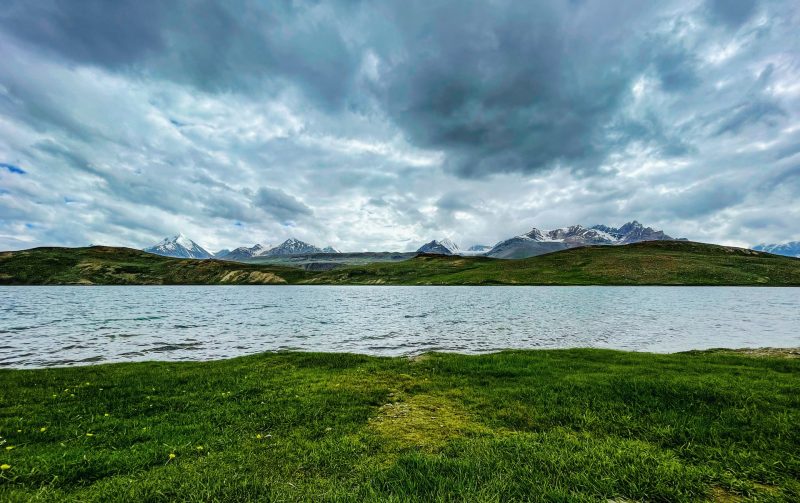
Chandratal Lake
Swimming is banned at the lake. Enjoy the weather, walk around and click pictures. This is one of the coldest places I have been to.
I couldn’t speak after hiking because I was not used to the hike and height! I suggest you cover your body with warm clothes and take tablets /glucose.
You can spend a night at camping spots near the lake. Camping on the banks of Chandratal lake within 3 kilometers is not allowed as per new rules. There are sharing and individual camping tents with washroom and dinner facilities.
Booking can be done online and directly. Two of the best camping sites are – Sakyacamp and Samsongcamp It’s safe to call the camping in charge before you visit. It costs you from INR 1300 to INR 2000.
Before you choose, check for toilet facilities, in some camps the facilities are the worst and not worthy of the amount you pay. You will get a simple and comfy bed with blankets. The food menu will be mostly vegetarian dishes. There are neither hotels nor shops to buy snacks, so it’s better to buy them from Kaza or Manali, depending on the route you chose.
After completing the dinner, take a short walk, bonfire under the skies, and interact with fellow campers.
You can also pitch your tent at the camping site, also check with nearby camping sites to use their washrooms at night.
Chandratal lake is one of the Ramsar wetland sites in India. It is home to some rare species like snow leopard, snow cock, golden eye eagle, etc. The richness of the site is being threatened by summer trekking, littering waste, and lack of sanitation facilities.
So please don’t litter while you stay in a camp.
Altitude – 4250 m above sea level.
How to reach?
Kasa-Losar-Kunzum Pass-Chandratal Lake: Kasa to Losar – 2 hours, Losar to Kunzum Pass – 45 mins, Kunzum Pass to Chandratal lake – 2 hours.
If you stop at eateries for a break, the time will extend accordingly.
Returning route – Chandratal lake – Batal – Rohtang Pass – Manali: Chandratal to Batal -1 hour, Batal to Manali – 5 hours.
If you cannot head to Manali from Batal, you can stay at Chacha Chachi Dhaba at Batal, because there are no other hotel stays available on this route. Try to reach Rohtang Pass before it gets dark. This route is one of the bumpiest and riskiest.
I even started to chant mantras in fear. Experienced drivers only can crack this way properly.
- River Rafting –
There are many locations on Spiti and pin rivers for river rafting. The best being Koksar to Tandi Bridge, the point where Chandra and Bhaga meet to form Chenab. September is the best time for rafting.
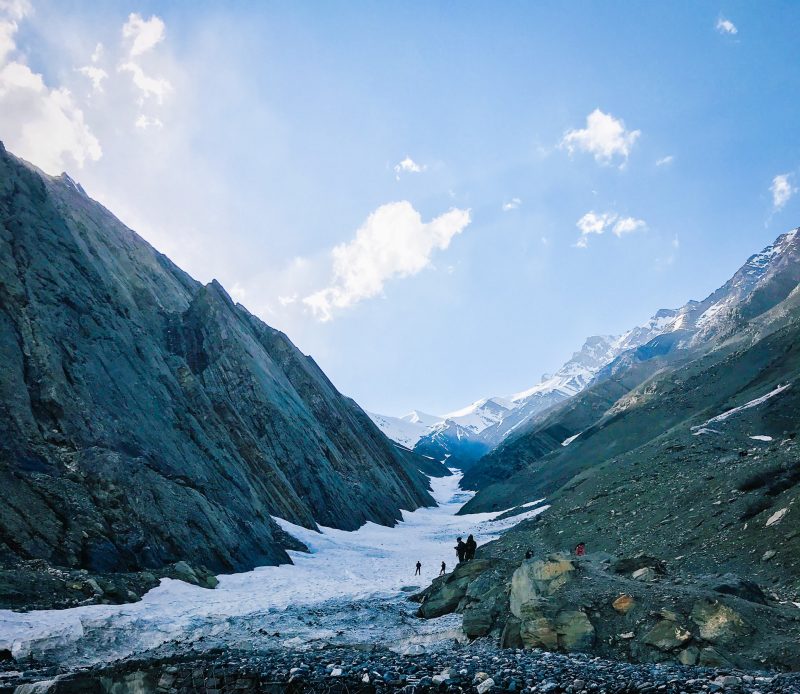
Spiti Valley River
Another option we have is rafting in Spiti, which is from Rangrik (4 km from Kaza). Route for this rafting will be Rangrik-Sichling-Nadang-Sumdo-Kaza/Kinnaur. You can book for the rafting on gio.in.
While going rafting please follow the instructions and keep your belongings safe. I have seen people lose their cards/photos/even mobiles.
Avoid drinking liquor before the rafting or while doing rafting. If you have fear of water, (just like me) blood pressure issues, heart problems, or breathing problems, it’s better to avoid them.
- Reckong Peo –
Reckong Peo is the pilgrim spot located at an altitude of 2300m. It is the administrative town of Kinnaur. You can visit Chandika temple, Bhabha valley, Bodh Mandir also there are apple orchards and pine valleys.
Kalpa is 13 km from Reckong Peo which is home to some of the peaks of the Himalayas – Kinner Kailash and Jorkanden.
How to reach –
You can reach Reckong from Kaza. The buses leave in the early morning. If traveling from Kaza towards Shimla with any of the places in between is on your itinerary like Tabo, you can board this bus and get down at any destination of your choice.
When you stay at Tabo, visit Tabo monastery, which is famous for its exquisite murals and stucco sculptures which bear a striking resemblance with the paintings and sculptures in the Ajanta caves. This is why Tabo has acquired the title of Himalayan Ajanta.
- Kinnaur Valley
“Land of Fairytales”, Kinnaur Valley is known for its cleanest air in the country according to research by IIT Delhi in 2016. There are two valleys – Sangla and Hangrang Valley.
If you’re interested in paragliding and camping together Sangla valley is the best pick. Kinnaur Kailash, which is closest to the Tibetan border, is a beautiful viewpoint. Kinnaur valley is prone to landslides, so visiting Kinnaur during the rainy season is not advisable.
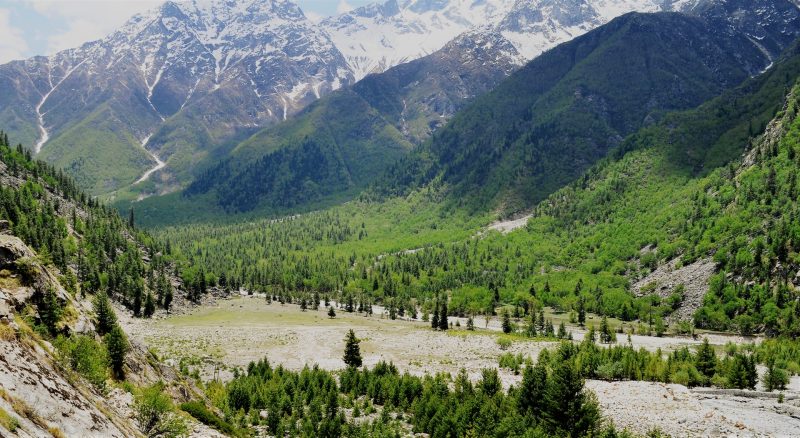
Kinnaur Valley
September to November is the right time to enjoy the Kinnaur valley trip, as the fall sets in. Snow starts to melt and the blooming season starts by this time. The valley’s shades are surreal, and the trees are flowering with orange leaves, adding to the beauty of the stunning backdrops on many levels.
How to reach –
Kinnaur Valley can be reached by road via Shimla and Rampur Bushahr. A daily bus to major towns in Kinnaur is also available from Shimla and Chandigarh.
- Pin Valley National Park
There is not much activity to do in Pin valley. If you want to experience the calm and serenity of nature, you can visit this valley. The confluence of Pin and Spiti rivers can be seen at Attargo bridge which can be reached from Kaza or Tabo. This park is the home for many endangered species like snow leopard, red fox, snow cock, etc.
The Forest department has constructed many inspection paths, bunkers, and one transit accommodation at Mud Farka in the National Park. Bunkers are situated at an interval of 10-15 km distance.
Local guides and porters are also available around the periphery of the Park. Chamurthi horses, the famous horses of this valley are also available for this purpose.
How to reach –
Kaza -Attargo Bridge – Pin valley: 16 km drive from Kaza will lead to Attargo bridge from there you can head to Pin village. Mud village is the last village in the pin valley. You can also hire a shared taxi from Kaza. Buses are available from Kaza daily, halting at night and then returning by the next morning.
- World’s Highest Post Office-
When did you write a letter to your dear ones? I have not written a letter in my life, not even a love letter 🙂 How about writing a letter or sending a postcard from the World’s highest Post office. Go to Hikkim, write a memorable letter or send a postcard, click a picture before the post office.
Hikkim, a village at a height of 4400 m was the world’s highest polling station earlier now it has the world’s highest post office. It is located 46 km from Kaza. It is shut during winter. Post-Master Rinchen Chhering is looking after the operations from 1983. Two other postmen walk on foot to deliver the post.
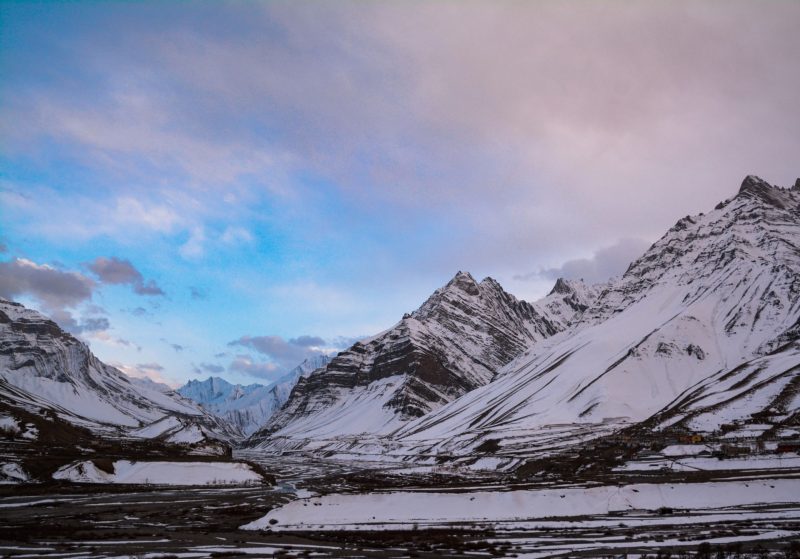
Pin Valley National Park, Spiti
How to reach?
There is a bus available from Kaza to Hikkim by 5 PM every day. This bus goes all the way to Komic which is about 3 kilometers ahead of Hikkim. It takes about 90 minutes to complete the journey because it also covers Langza on the way. The same bus then starts from Komic at 7.30 AM and travels back to Kaza via Hikkim and Langza.
By Taxi: Drive from Kaza towards Manali. About 1.5 kilometers out of the town, you will notice a road going uphill towards your right. This is the one you need to turn on. It is a small road and can be missed so please ask the locals if you are unsure.
The road towards Hikkim is before the Rangrik bridge and Kye Monastery so if you reached either of these places, you have gone a little too far ahead. I will post a map below for better understanding. For the journey ahead, it is a complete circuit and you can either do it in the form of Kaza – Langza – Komik – Hikkim – Kaza or the other way around.
- Last Motorable Road
Mudh/Mud village, pronounced as Moodh by locals, is one of the last Motorable roads. Located at an altitude of 3700 m, one can reach mudh village from Kaza. Daily buses are available from Kaza, which halts at night and returns to Kaza by 6.00 AM.
If you are visiting Pin Valley from Tabo, stay at Mud Village by night and then head to Kaza.
- Skiing
The winter in Lahaul is longer than in other parts of the state. Due to the chilly temperature, the snow quality in Lahaul is ideal for skiing. You can inquire with trip operators such as Potala Adventurers about ski guides in Lahaul. Many local centres offer skiing activities; be sure to check the pricing and what is included in the package.
Skiing in Narkanda is also a great experience; the skiing season runs from December to February.
However, depending on the weather, the activity may be postponed or cancelled. Check with organisers such as Tethys to find out when skiing is allowed in Narkanda and plan your trip appropriately.
Skiing at Narkanda is suitable for beginners too. Charges for two hours of skiing can cost you up to Rs 2000. Do not forget to carry skiing shoes, sunglasses, sunscreen, comfortable pants/trousers for skiing.
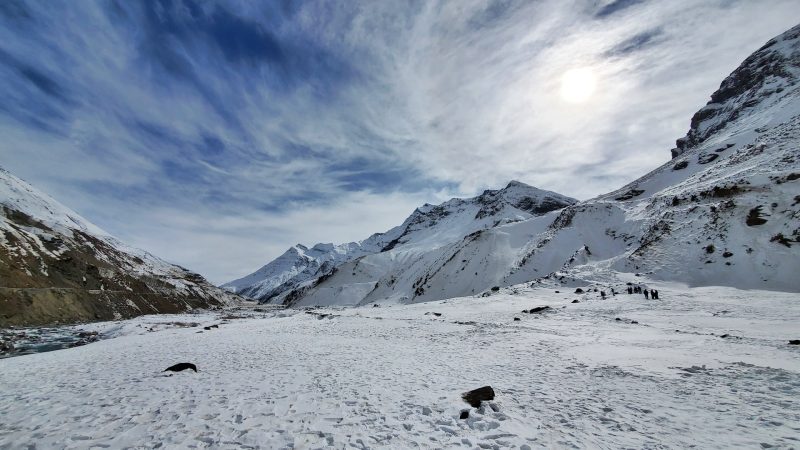
Spiti Winterland
- Shop until you drop –
A trip is never complete without a visit to the famed marketplaces or bazaars of the destination. Kasa market, one of the busiest marketplaces in the Spiti Valley, is known for handicraft products, woolen apparel, and pashmina shawls. Dried fruits come in a variety of varieties that can be found at local stores.
Barley coffee and peas are among the most often grown crops in this region. Barley coffee is a great option for coffee enthusiasts, especially vegans. Fruit enthusiasts must sample the handcrafted jams and jellies prepared from seabuckthorn and apples.
Emporiums in Kaza sell Chinese pottery items and ornaments such as rings, bracelets, and lockets.
Spiti Ecosphere – This social enterprise from Spiti is working on the conservation of the environment and sustainability. It is a collective group of volunteers from different spheres, who are giving back to the community.
You can also volunteer with them for 15 days or do an internship for 1 month. The activities include organic farming, staying with the locals and getting to know their culture, or teaching the students.
Spiti’s Ecosphere is located at Kaza market, where they sell handmade products like fridge magnets, keychains, and souvenirs. Profit on selling these products goes to the locals who made the products.
It is undoubtedly a worthwhile experience to visit!
- Feast to your Taste Buds
Simple Tibetan food is available all over the Spiti Valley. If you are a South Indian like me, you have to adjust with roti and long sticky rice throughout the trip. Locals use fresh vegetables like potatoes, and peas are grown in the valley for preparing the food.
For non-veg lovers, you will get chicken, mutton, lamb, and freshwater fish.
Shahi Thali in Komic village is widely suggested by locals. Beer lovers should try Chhang, a special beer made by the local people of spiti valley. It is sold at every home mostly Momo’s (dumplings) and Thukpa (thick noodles in soup), Cha – a salted tea, Sattu drink made using Barley flour are the other options to try.
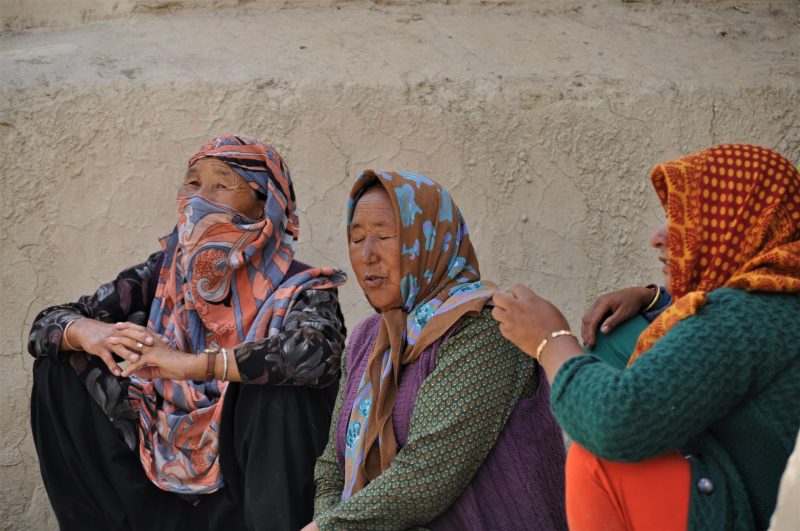
Glimpse of Himachal people
Butter tea is available at many shops. These are not made out of Butter, but yak cheese. Yes, you heard it right. Yak cheese, known as Chhurpi/Churru cheese, is like a stone dropped inside the tea.
Spiti Valley in Winter Packing List
Outerwear like puffer jackets and parkas
The Spiti winter is harsh, so carrying good jackets is important. Waterproof jackets will be more convenient for winter Spiti expeditions. Puffer jackets from Kosha are suitable for 15°C to 5°C* when worn as is, without layers. Suitable for 5°C to -5°C* with layers like thermals/sweaters/hoodies.
You can check out warm jackets for men here.
You can check out warm jackets for women here.
Sweaters and Pullovers
Sweaters, made of soft Merino wool that is naturally odor-resistant and skin-friendly, are a must-have for any valley winter trip. Pullovers from Kosha will give you a stylish and comfortable look. It is suitable for 20°C to 10°C* when worn as is without layers. With layers, it can be worn from 10°C to -5°C.
You can check out neat sweaters for men here | For women here
You can check out comfy sweatshirts for men here | For women here
You can check out stylish pullovers for men here | For women here.
Baselayers
Base layers are suitable for 15°C to 10°C* when worn as is, as thermals/tees/leggings. When worn as a base to other layers suitable for 10°C to -20°C. The base layers from Kosha can also be worn as a T-shirt. As a result, there is less room for packing.
You can check out merino wool thermals for men here.
You can check out merino wool thermals for women here.
Woolen bottoms – Snow Pants
For surviving the Spiti winter, choosing the right winter bottoms is important. With inbuilt moisture wicking and odour resistant properties, Kosha’s thermal bottoms can be worn for 3 to 5 days at a time without washing.
You can check out merino wool thermal bottoms for men here | For women here
You can check out ski pants for men here | For women here.
Warm accessories
You will undoubtedly feel cold if you do not cover your ears during your travel as the air passes through your body. When hiking, gloves are required, and wearing gloves will keep you warm even at night. Try touchscreen-friendly warm accessories from Kosha, for your spiti trip, without fail.
You can check out mufflers and caps for men here.| For women here.
You can check out gloves for men here. | For women here.
Warm shoes or snow boots
You need to carry Warm shoes or snow boots for the Spiti trip. This will help a lot if you’re trekking or walking on mud roads.
You can check out winter boots for men here | For women here.
Warm socks
Warm socks are required for a good night’s sleep in Spiti. Numbness can be avoided by wearing socks at night.
You can check out winter socks for men here.
You can check out winter socks for women here.
Importance of layering in Spiti Valley in winter
Do you know how to keep yourself safe when visiting places at such heights? I didn’t know either till I visited spiti.
An ounce of prevention is worth a pound of cure. Not only do we need to protect ourselves from the cold, but we also need to protect ourselves from the temperature. This is when the art of layering comes into the picture.
There are three types of layers available, and I have explained below-
- Base Layer – The base layer is the one closest to your skin. It serves as a haven for us. Imagine a T-shirt that doubles as a base layer. Kosha has a variety of gender-neutral color T-Shirts that can be used as a base layer. Because they’re constructed of merino wool and bamboo, they won’t itch your skin.
Because the fiber resembles fish scales, it dries quickly. Anti-odor properties of the base layer make you use it without washing it for 3 to 5 days.
Check out the base layer products from Kosha’s store here.
2.Mid layers –
The Mid layers are made up of pullovers and sweatshirts. This is worn after the base layer. Women’s Merino wool pullovers, fleet sweatshirts, and Buttoned Cardigans are available from Kosha.
Reversible merino pullovers are available. You can bring two pullovers on the trip and use one for three days, then dry it and use the other side for the remaining days.
It reduces the amount of time and space we need to pack. Supima pullovers from Kosha are another long-lasting option. It’s made of high-quality Supima cotton. The natural shine of this cotton variety adds beauty to these t.shirts.Ladies, you can style your sarees by wearing Cardigans on top of it.
Hoodies from Kosha come with 6 pockets of varying sizes with zippers. 2 front hand pockets, 1 concealed pocket for your phone with an earphone outlet, 2 larger pockets for documents, tabs, or snacks, and 1 chest pocket.
Check out the Mid layer products from Kosha’s store here.
- Thermal Layers –
A good thermal layer is essential to cover all of the gaps through which cold air passes. Kosha’s weatherproof jackets are the best thermal layer you can get. The sleeves of the jacket are constructed in such a way that no air can pass through.
The jackets have a detachable hood and a waterproof Breathable Outer layer.
Thermal layers are the final layer of protection from shivering temperatures. So pick the right one from here.
- Accessories –
The Accessories set includes gloves, socks, caps, mufflers, and Shawls. Gloves protect our hands from becoming numb. Monkey caps/mufflers can be used to cover our ears. Socks are essential during the night when the temperature drops. Kosha offers two varieties of socks: one made of cotton and the other of Merino wool. Check out the winter accessories here.
The weather is harsh in Spiti and unpredictable. Some days the sun was scorching and I was wondering whether I was in a hill station. While layering two important things had to be considered.
- Layering depends on an individual’s resistance to cold Example – I may feel cold at day time while traveling so I will add all three layers, cover with accessories to make myself warm, and at the same time you don’t feel cold and you have a natural resistance to cold, then you can stop till mid-layer or your choice of layering.
- Not only the temperature affects the layering, but also the weather.
During the harsh winter months of January to April, temperatures in the Spiti will be quite low. May to July, or September to October, are the finest months to visit. The temperature can drop to 2 to 3 degrees Celsius at night or early in the morning during these four months as well.
It is preferable to wear all three layers, as well as accessories when the temperature drops this low.
Wear a base layer that is closest to your skin and wrap yourself in a sleeping bag during your camping trip.
Remember to blow air into your sleeping bag to be warm and safe.
Depending on the temperature, you can wear either merino or cotton socks from Kosha.
If the temperature is normal during the day, you can wear the base layer alone or the base and mid-layer together, depending on your preference.
Another key factor to remember is that you will feel very cold for the first few days before acclimating to the weather. Within four to five days, you will see a difference.
As a result, layering can be done based on acclimatization.
For example, if you’re traveling from a tropical location, you’ll need a few days to adjust to the weather in Spiti. You’ll be back to normal after the first week and begin to acclimatize like a Spiti local.
Important Tips-
- Roads – The roads in the Spiti valley are the worst and riskiest. I would not recommend road trips in small cars/bikes. Gear up your vehicle properly. Even the good and strong cars have struck up inroads. Hire a good and experienced driver, who can handle such bumpy roads. Start early in the morning so that night drives can be avoided.
- Take care of your belongings, especially the id cards, mobiles, cameras, and wallets.
- Carry Id cards, you need to get vehicle permits in Rohtang Pass.
- Carry Sanitiser, because we cannot wash our hands often in cold water.
- If you’re experiencing breathlessness or high blood pressure, see a doctor and get some basic medications. Maintain a healthy level of hydration. I recommend that you see a doctor before going on your hiking or camping trip.
- When you travel to regions at such high altitudes, your oxygen levels will decline. Acclimatization is the process through which your body adjusts to variations in oxygen levels.
Always remember that different people acclimate at various rates. Because our body breath reduces as we sleep, the symptoms will worsen. In such unforeseen circumstances, do not be alarmed. This can happen to anyone, regardless of age or fitness level.
Allow a couple of days for acclimatization before venturing up to Spiti’s higher villages.
If you become ill, you can go to the government hospital in Kaza.
Also, do not take children on a trip to Spiti. This trip can be difficult even for the fittest persons. So don’t take a chance and ruin your vacation.
- Kaza has one petrol bunk and one ATM. There aren’t any other places where you can fill both your car and your wallet.
- Carry masks, sunscreen, sanitary napkins, first aid kit, glucose, electrical powder, your water bottle – refill it whenever you stop at a motel.
- If you eat oily food in dhabas, you will have digestive problems while traveling. As much as possible, eat light foods.
- Above all, I’d like to emphasize the importance of “not littering waste.” Locals keep their neighborhoods clean, so please dispose of trash only in containers and not on the streets. Avoid purchasing water bottles and instead refill your bottles as needed.
Don’t litter the locations you visit because they are home to uncommon creatures. Keep in mind that we all live on the same planet.
I believe I have covered every aspect of the Spiti trip. Hope it will be useful for planning your Spiti trip.
After completing my first solo trip, I believed these lines were profound: “If you never travel, you will never know.”Though this journey was difficult in many ways, when I reflect on the memories, it was a beautiful experience.
This blog article is written by Kosha Team Member – Keerthiga Rani.
